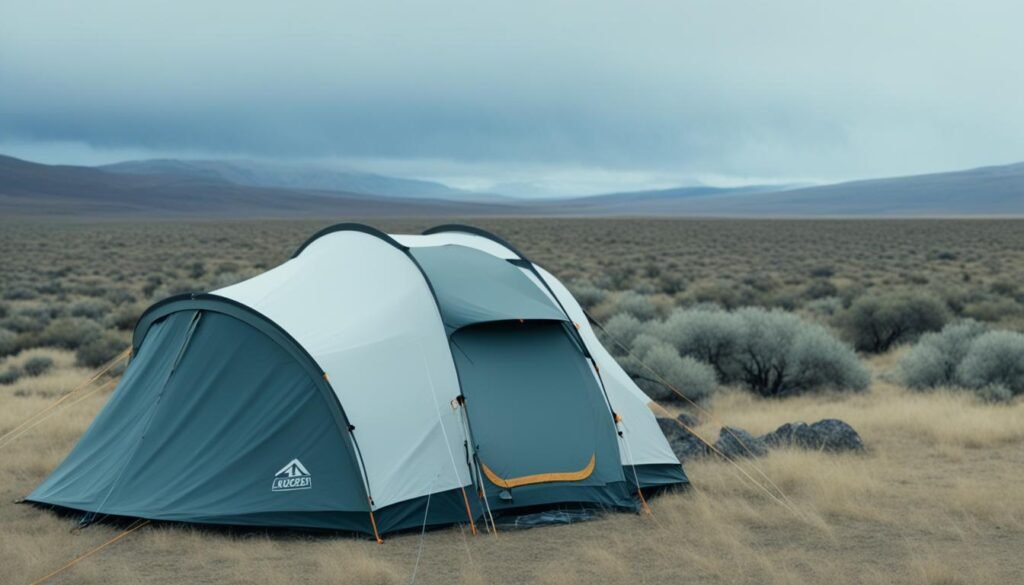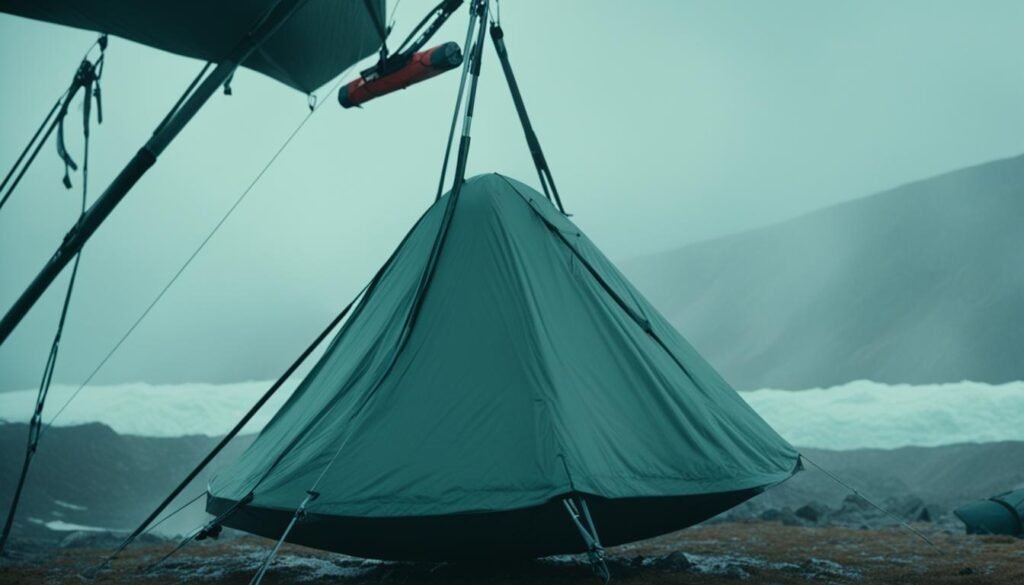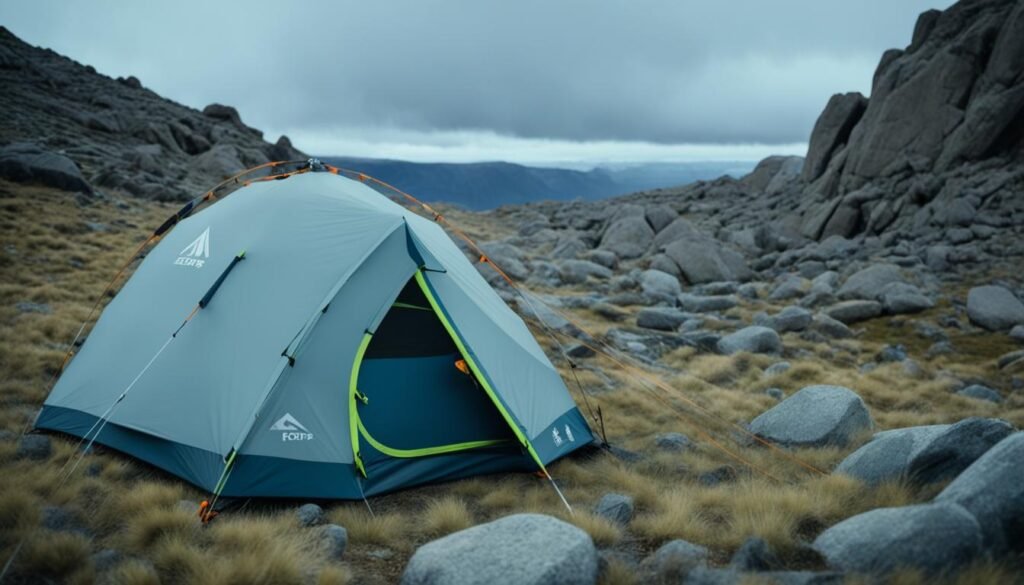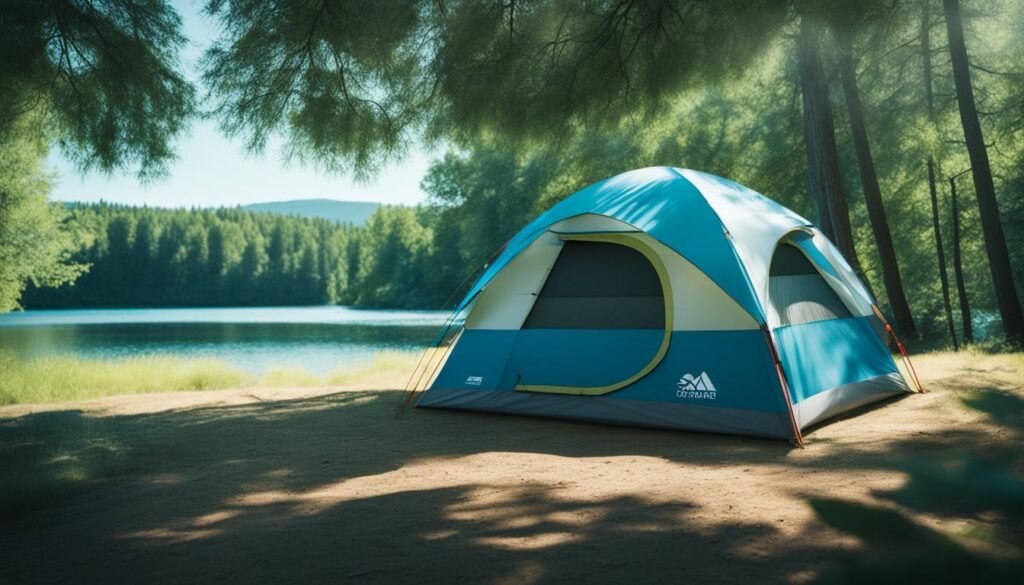When camping in windy conditions, one of the most important tasks is to secure your tent properly. The last thing you want is for your tent to be blown away, putting you and your fellow campers at risk. By following the right techniques and using the right equipment, you can ensure a secure and worry-free camping experience, even in the face of strong winds.
Key Takeaways:
- Choose a wind-resistant tent designed to withstand strong winds.
- Anchoring and pitching your tent correctly is crucial for stability.
- Maximize wind resistance with the use of guy lines.
- Select a wind-protected location for pitching your tent.
- Be prepared for windy conditions and secure loose parts of your tent.
Understanding the Importance of Secure Tent Setup
Properly securing your tent is crucial for several reasons. Firstly, an unsecured tent can pose a danger to those inside and outside, as it can become a hazard if lifted by the wind. Additionally, a tent that blows away can leave you without shelter for the duration of your camping trip. It’s also important to choose a tent that is designed to be wind-resistant for added protection.
Preventing Hazards and Ensuring Safety
When camping in windy conditions, the wind can easily turn your tent into a potential hazard. An unsecured tent can be lifted and thrown, causing injury to individuals nearby or damage to surrounding property. By properly securing your tent, you minimize the risk of accidents and ensure the safety of both yourself and others.
Protection From the Elements
A tent that blows away not only leaves you without shelter but also exposes you to the elements. Wind, rain, and other weather conditions can make camping a miserable experience without the protection of a secure tent. By properly setting up and anchoring your tent, you create a stable and reliable shelter, keeping you dry, warm, and comfortable throughout your camping trip.
Choosing a Wind-Resistant Tent
Another important aspect of securing your tent is investing in a wind-resistant model. Wind-resistant tents are specifically designed to withstand strong winds, with features such as reinforced poles, sturdy materials, and aerodynamic shapes. These tents provide added stability and durability, reducing the risk of your tent being damaged or blown away in windy conditions.
Ensuring Peace of Mind
By securing your tent properly, you can have peace of mind knowing that your shelter is safe and secure, even in challenging weather. You can relax and enjoy your camping experience without constant worry about your tent being blown away or causing harm to others. Properly securing your tent not only protects your investment but also adds to the overall enjoyment and safety of your camping trip.
| Importance of Secure Tent Setup | Benefits |
|---|---|
| Prevents hazards and ensures safety | – Minimizes the risk of accidents and injuries – Protects surrounding property – Safety for individuals nearby |
| Protection from the elements | – Ensures a reliable shelter – Keeps you dry and warm – Provides comfort during your camping trip |
| Choosing a wind-resistant tent | – Increased stability and durability – Reduces risk of damage or tent being blown away – Suitable for challenging weather conditions |
| Ensuring peace of mind | – Security and confidence in your shelter – Enjoyment of camping without constant worry – Protection of your investment |
Selecting a Wind-Resistant Tent
When camping in windy conditions, choosing a tent that can withstand strong winds is crucial for a safe and comfortable experience. While ultralight tents are popular for their lightweight design, they may not provide the necessary strength and durability needed in high winds. Instead, consider tents that are specifically designed to handle windy conditions.
Wind-resistant tents are equipped with features that enhance their ability to withstand strong gusts. These tents often have aerodynamic designs that reduce wind resistance and prevent the tent from being easily lifted. Look for tents made from wind-resistant fabrics that can withstand the force of the wind without tearing or ripping.
When shopping for a wind-resistant tent, keep in mind the expected wind conditions you will encounter during your camping trips. Look for tents that have been tested and rated for wind resistance, such as those with a high wind speed rating. These tents have undergone rigorous testing to ensure they can withstand strong winds without compromising their structural integrity.
“Choosing a wind-resistant tent is essential for a safe and enjoyable camping experience in windy conditions. These tents provide the necessary stability and durability to withstand strong gusts, keeping you protected and comfortable throughout your trip.”
It’s also important to consider the size and shape of the tent. Dome tents tend to perform well in windy conditions due to their rounded shape, which allows wind to easily flow over and around the tent. Additionally, consider the number of guyline attachment points available on the tent. Guylines can provide additional support and stability, helping to anchor the tent firmly in place.
When selecting a wind-resistant tent, take into account the overall quality and construction of the tent. Look for reinforced seams, sturdy zippers, and robust pole systems that can withstand the rigors of strong winds. It’s worth investing in a high-quality tent that will provide long-lasting durability and reliable performance in windy conditions.
| Tent Feature | Benefits |
|---|---|
| Aerodynamic design | Reduces wind resistance and prevents tent from lifting |
| Wind-resistant fabrics | Withstands strong winds without tearing or ripping |
| High wind speed rating | Tested and rated for wind resistance |
| Dome shape | Allows wind to flow over and around the tent |
| Multiple guyline attachment points | Provides additional support and stability |
| Reinforced seams, sturdy zippers, and robust pole systems | Ensures long-lasting durability and reliable performance |
By selecting a wind-resistant tent that is designed to withstand strong winds, you can ensure a safer and more comfortable camping experience in windy conditions.
Proper Anchoring and Pitching Techniques
When camping in windy conditions, it’s crucial to anchor and pitch your tent correctly to prevent it from blowing away. By using strong tent stakes and guylines, you can enhance the stability of your tent and protect it from the powerful forces of the wind.
Securing with Tent Stakes
One of the key components of anchoring your tent is using high-quality tent stakes. These stakes should be strong and durable enough to withstand strong winds. When driving the stakes into the ground, make sure to insert them at a 45-degree angle, as this provides optimal resistance against wind forces. Drive the stakes deep into the ground to ensure a secure anchor for your tent. Properly staking down your tent is essential for its stability and resistance to high winds.
Utilizing Guylines for Extra Stability
In addition to tent stakes, guylines are a valuable tool for enhancing the stability of your tent in windy conditions. Guylines are ropes that attach to your tent and provide additional support against the wind. They distribute the stress of the wind more evenly and prevent your tent from being lifted or blown away. Attach guylines to the corners and sides of your tent, and secure them to the ground with stakes. Adjusting the tension of the guylines helps keep your tent taut and prevents sagging.
Orienting and Pitching Techniques
Properly orienting your tent and following specific pitching techniques are also important for maximizing stability in windy conditions. Position your tent with the wind in mind, facing the lowest and smallest end of the tent towards the wind. This helps reduce the surface area exposed to the wind, minimizing the chances of your tent being caught by strong gusts. Additionally, tautly pitch your tent to minimize flapping and movement.
“Anchoring and pitching your tent correctly is essential to prevent it from blowing away. Use strong tent stakes and drive them deep into the ground to secure your tent.”
By combining strong tent stakes, guylines, and proper pitching techniques, you can ensure that your tent remains secure and stable even in challenging windy conditions. Taking the time to anchor and pitch your tent correctly is well worth the effort to ensure a safe, enjoyable, and worry-free camping experience.
Maximizing Wind Resistance with Guy Lines
When camping in windy conditions, it’s crucial to maximize the wind resistance of your tent. One effective method to achieve this is by utilizing guy lines. Guy lines are cords that attach to the corners and sides of your tent, providing additional support and stability.
By distributing the stress of the wind more evenly, guy lines help prevent your tent from being blown away. They anchor your tent firmly to the ground, minimizing the risk of damage or displacement.
To set up guy lines, attach them securely to the designated attachment points on your tent. You can then use tent stakes to secure the other end of the guy lines into the ground. Ensure the guy lines are taut, but not overly tight, to maintain the proper tension and prevent sagging.
Using guy lines in windy conditions offers several benefits:
- Enhanced stability: Guy lines provide additional support to your tent, reducing its vulnerability to strong winds.
- Better weight distribution: By evenly distributing the force of the wind, guy lines help prevent localized stress points on your tent, minimizing the risk of damage.
- Improved wind resistance: The strategic placement of guy lines helps your tent maintain its shape and structural integrity even in gusty conditions.
By incorporating guy lines into your tent setup, you can significantly increase its wind resistance, ensuring a secure and comfortable camping experience. With your tent properly anchored and stabilized, you can rest easy knowing that it will withstand even the strongest winds.
Importance of Staking Down Your Tent Properly
When it comes to securing your tent, one of the most crucial steps is staking it down properly. By using secure tent stakes and driving them deep into the ground at a 45-degree angle, you can ensure a strong anchor that prevents your tent from being lifted by the wind.
Properly staking down your tent is essential for its stability and resistance to high winds. Without secure tent stakes, your tent becomes vulnerable to the forces of nature, leading to potential damage and an uncomfortable camping experience.
Secure tent stakes act as the foundation of your tent, providing the necessary support and preventing it from being easily uprooted. By driving them into the ground at an angle, you create a firm hold that withstands the strongest gusts of wind.
When selecting tent stakes, opt for sturdy and durable options that are designed to withstand challenging weather conditions. Look for stakes made from materials like aluminum or steel, as they offer the strength needed to anchor your tent securely.
Remember to drive the stakes deep into the ground to maximize their effectiveness. The 45-degree angle helps create a diagonal force that reinforces the stability of the stakes and minimizes the risk of them loosening or being dislodged by the wind.
The Importance of Tent Stakes in Wind
Secure tent stakes play a crucial role in ensuring that your tent remains firmly in place even in windy conditions. When the wind picks up, it exerts significant pressure on your tent, attempting to lift it off the ground.
Without properly staked tent stakes, your tent becomes susceptible to this force and may be carried away, resulting in potential damage and an unsafe camping environment. The strong grip provided by secure tent stakes prevents this from happening, helping to keep your tent firmly rooted to the ground.
“Properly staking down your tent is essential for its stability and resistance to high winds.”
By taking the time to stake down your tent properly, you can protect your investment and ensure a more enjoyable camping experience. So before embarking on your outdoor adventure, make sure to prioritize the proper staking of your tent to keep it secure and stable.
Staking Down Your Tent Properly: Step by Step
Here’s a step-by-step guide to help you stake down your tent properly:
- Choose sturdy and durable tent stakes made from materials like aluminum or steel.
- Position the stakes at a 45-degree angle to maximize their stability.
- Drive the stakes deep into the ground, ensuring a firm hold.
- Attach the guylines of your tent to the stakes for added stability.
- Check the tension of the guylines to ensure your tent is taut.
Following these steps will help you create a solid foundation for your tent, allowing it to withstand strong winds and inclement weather conditions.
Remember, proper staking is just one of the many steps in securing your tent in windy conditions. Utilizing additional techniques such as using guy lines and choosing a wind-protected location further enhances the stability and reliability of your tent.
Next, let’s explore the importance of choosing a wind-protected location for setting up your tent.
| Secure Tent Stakes | Importance of Tent Stakes in Wind | Staking Down Tent Properly: Step by Step | |
|---|---|---|---|
| Definition | Tent stakes that provide a strong anchor and prevent the tent from being lifted by the wind. | Tent stakes play a crucial role in keeping the tent firmly rooted to the ground even in windy conditions. | A step-by-step guide to properly staking down your tent for enhanced stability. |
| Importance | Ensures the stability and resistance of the tent in high winds. | Prevents the tent from being carried away by strong gusts of wind. | Creates a solid foundation for the tent, enhancing its ability to withstand challenging weather conditions. |
| Benefits | Protects your tent from potential damage and provides a more comfortable camping experience. | Secures your tent and maintains a safe and stable camping environment. | Allows your tent to withstand strong winds, providing peace of mind during your outdoor adventures. |
Choosing a Wind-Protected Location
When camping in windy conditions, selecting the right location to pitch your tent is crucial for a secure and comfortable camping experience. Choosing a wind-protected spot can significantly reduce the impact of wind on your tent and ensure a more enjoyable trip.
One of the key considerations when choosing a location is to look for areas that offer natural wind protection. This includes spots that are sheltered from the wind, such as behind hills, trees, or other natural windbreaks. These features can act as barriers, reducing the force of the wind and providing a more sheltered camping spot for your tent.
Benefits of a Sheltered Camping Spot:
- Reduced wind exposure for increased tent stability
- Protection against strong gusts that can damage your tent
- A more comfortable camping experience with less noise and debris
Avoid pitching your tent in open areas or flat ground, as these are more susceptible to strong gusts and offer little to no natural wind protection. By choosing a wind-protected location, you can significantly enhance the stability and durability of your tent, ensuring it remains securely in place even in challenging wind conditions.
Furthermore, when selecting a wind-protected spot, consider the direction of the prevailing wind. Position your tent with the lowest and smallest end facing the wind to minimize the windward surface area and reduce the chances of your tent being buffeted by strong gusts. This strategic tent placement can add an extra layer of protection against the wind and enhance the overall stability of your shelter.
By carefully choosing a wind-protected location for your camping adventure, you can create a peaceful and secure haven amidst challenging wind conditions. The right spot can make all the difference in ensuring a successful and enjoyable camping experience.
Using Additional Anchoring Methods
In situations where staking your tent is not an option, there are alternative methods you can use to anchor it securely. By utilizing additional anchoring methods, you can ensure that your tent stays in place even in strong winds.
Weighted Objects as Anchors
An effective way to anchor your tent without staking it is by using heavy objects as anchors. Rocks or logs placed around the base of your tent can provide the extra weight needed to keep it secure. Make sure that these objects are stable and do not pose a tripping hazard.

Wind Straps for Added Support
Another reliable method to prevent your tent from blowing away is by using wind straps. These straps attach to your tent and go around nearby sturdy objects, such as trees or large rocks. The tension created by the wind straps adds extra support and stability to your tent.
“When staking your tent is not an option, using heavy objects or wind straps can be effective alternative methods to anchor your tent.” – Outdoor Expert
Using additional anchoring methods gives you peace of mind, knowing that your tent will stay in place even in challenging weather conditions. Whether it’s utilizing weighted objects as anchors or employing wind straps, these methods provide the extra support needed to keep your tent secure.
Preparation for Windy Conditions
Being prepared for windy camping conditions is essential to ensure a successful and safe outdoor adventure. By taking the necessary precautions and having the right gear, you can confidently face strong winds and enjoy your camping experience without worrying about your tent blowing away. Here are some tips to help you prepare for windy conditions:
Gather Your Gear
Before you embark on your camping trip, gather all the necessary equipment and gear that will help you withstand strong winds. Make sure to have:
- Tent stakes: Ensure that your tent stakes are easily accessible and in good condition. Consider using stakes specifically designed for windy conditions for added stability.
- Tent poles: Assemble your tent poles in advance to save time and effort when setting up your tent in windy conditions.
- Additional anchor gear: Have extra gear like rocks or sandbags that can act as anchors in case your tent stakes are not sufficient.
Familiarize Yourself with Wind-Resistant Techniques
Take the time to learn and practice wind-resistant techniques for setting up your tent. This includes understanding the proper way to anchor your tent with stakes and utilizing guy lines for added stability. Familiarize yourself with the instructions provided by the tent manufacturer to ensure a secure setup.
Check Weather Forecasts
Stay updated on weather forecasts for your camping location, paying close attention to wind warnings. If there are predictions of strong winds, consider rescheduling your trip or choosing a more sheltered camping spot.
Secure Loose Items
Before setting up your tent, secure any loose items in your campsite, such as camping chairs, cooking equipment, and personal gear. Strong winds can easily pick up loose items and cause damage or create hazards.
Be Flexible with Your Setup
When setting up your tent in windy conditions, be flexible and adapt to the changing wind direction. Position your tent with the lowest and smallest end facing the wind to minimize its impact on your tent’s stability. Adjust the tension of your guy lines to keep your tent taut and prevent sagging.
By following these preparation tips and having the right gear, you’ll be well-prepared to face windy camping conditions. Remember, being proactive in your preparations is key to ensuring a comfortable and secure camping experience.

Setting Up Your Shelter in Windy Conditions
When faced with strong winds, it’s important to follow these tips for a successful and secure tent set-up. By taking the right steps, you can ensure that your shelter withstands the elements and provides a safe haven during your camping adventure.
Positioning your tent
When selecting a spot to pitch your tent, consider the direction of the wind. It’s best to position your tent with the smallest and lowest end facing the wind. This helps reduce wind resistance and prevents the tent from catching too much force.
Firmly staking down your tent
Properly securing your tent with stakes is crucial in windy conditions. Insert the stakes at a 45-degree angle towards the tent for maximum stability. This angle helps anchor the tent firmly to the ground, minimizing the risk of it being lifted by strong gusts. Make sure to drive the stakes deep enough to provide a solid hold.
Using guy lines for added stability
Guy lines play a vital role in distributing the stress of the wind and keeping your tent taut. Attach guy lines to the corners and sides of your tent, and secure them to the ground with stakes. Adjust the tension of the guy lines as needed to maintain the stability of your shelter. By evenly distributing the force of the wind, guy lines help prevent your tent from collapsing or being blown away.
Remember, proper shelter set-up in windy conditions is crucial for a safe and enjoyable camping experience. By positioning your tent strategically, firmly staking it down, and using guy lines effectively, you can ensure that your shelter stands strong against the wind. Now that you’ve learned these valuable tips, you’re ready to set up your tent and embrace the great outdoors, even in strong winds.
Using Your Shelter’s Wind Resistance Features
When camping in windy conditions, it’s important to take full advantage of the wind resistance features built into your tent. These features are designed to increase the stability and durability of your shelter, enabling it to withstand strong winds and harsh weather conditions. By utilizing these features, you can ensure a safe and secure camping experience.
Benefits of Wind-Resistant Tent Design
Wind-resistant tents are specifically designed to prioritize strength, durability, and aerodynamics. These tents are constructed with sturdy materials and reinforced stitching to withstand the force of the wind. The shape and design of wind-resistant tents also minimize the impact of strong gusts, reducing the risk of the tent collapsing or being blown away. Investing in a wind-resistant tent provides the following benefits:
Increased Stability: Wind-resistant tents are built to remain stable even in high winds, providing a reliable shelter for you and your camping gear.
Enhanced Durability: The materials used in wind-resistant tents are more robust, allowing them to withstand the wear and tear caused by wind and harsh weather conditions.
Improved Aerodynamics: The streamlined design of wind-resistant tents reduces wind resistance, preventing excessive movement and minimizing the risk of damage.
By choosing a tent with wind-resistant features, you can ensure that your shelter remains secure and intact, even in challenging weather conditions.
Utilizing Tent’s Wind Resistance Features
To fully utilize your tent’s wind resistance features, follow these tips:
- Set up your tent according to the manufacturer’s instructions, paying close attention to securing all attachment points and guylines.
- Make use of internal guylines, which are strategically placed inside the tent to provide additional stability.
- Adjust the tension of guylines and attachment points to keep the tent taut, reducing flapping and movement in the wind.
- Ensure that all zippers and closures are properly secured to prevent wind from entering and destabilizing the tent.
By implementing these strategies, you can optimize your tent’s wind resistance features and enjoy a comfortable camping experience, even in challenging windy conditions.
Comparative Table of Wind-Resistant Tents
| Tent Model | Material | Design Features | Wind Resistance Rating |
|---|---|---|---|
| Brand X WindMaster | Durable ripstop nylon | Aerodynamic shape, reinforced stitching, internal guylines | 5/5 |
| Brand Y StormShield | Strong polyester fabric | Tub-floor construction, multiple attachment points, wind-blocking panels | 4/5 |
| Brand Z GustBuster | Heavy-duty canvas | Geodesic dome design, additional guyline attachments, sturdy poles | 4/5 |
This table presents a comparison of wind-resistant tents available in the market. The rating, on a scale of 1 to 5, indicates the overall wind resistance of each tent model. Consider these factors when choosing a wind-resistant tent that best suits your camping needs and expected weather conditions.
Adding Weight for Extra Stability
If staking down your tent is not enough to secure it in windy conditions, there are additional measures you can take to provide extra stability. Adding weight to your tent can help prevent it from being lifted by strong winds and ensure its stability throughout your camping trip.
One effective method is to place heavy objects like rocks or logs around the base of your tent. These objects act as additional anchors, anchoring the tent to the ground and reducing the risk of it being blown away. By strategically positioning these weighty items around the perimeter of your tent, you can significantly increase its resistance to wind forces.
When choosing rocks or logs to use as anchors, opt for those that are large and sturdy. Rocks should be sizable enough to provide substantial weight, while logs should be thick and securely wedged in the ground. Ensure that the objects you select are appropriate for the terrain and are unlikely to shift or roll in the wind.
By using rocks or logs as anchors, you can strengthen the stability of your tent and enhance its resistance to windy conditions. This additional weight provides extra holding power, keeping your tent firmly in place even in gusty weather.

| Pros | Cons |
|---|---|
| Provides extra stability | Requires finding suitable heavy objects |
| Helps prevent the tent from lifting | May be challenging to find rocks or logs |
| Enhances resistance to windy conditions | Requires additional effort during setup and takedown |
| Relatively simple and cost-effective solution | Weight may need to be adjusted based on wind intensity |
Adding weight to your tent is a practical and effective way to ensure extra stability in windy conditions. By using rocks or logs as anchors, you can further secure your tent and enjoy a safe and comfortable camping experience, even when the winds are strong.
Keeping Loose Parts Secure
When it comes to camping in windy conditions, securing loose parts of your tent is vital to prevent damage and maintain overall stability. The flaps and doors of your tent can easily become vulnerable in strong winds, so it’s important to take extra precautions to keep them secure.
To ensure maximum protection, make sure to close all tent flaps tightly and securely. This will prevent them from being caught by the wind and potentially causing damage to your tent. You can also use additional measures such as fastening the flaps with hooks or toggles to provide extra security.
Additionally, properly securing the doors of your tent is essential. Ensure that all zippers are fully closed and securely tied off to prevent them from flapping around in the wind. This not only protects your tent from potential damage but also helps maintain a comfortable and insulated interior.
Remember, strong winds can cause significant stress on the structure of your tent, so it’s important to take proactive steps to prevent any loose parts from becoming a liability. By keeping flaps and doors securely closed, you can minimize the risk of damage and maintain the overall stability of your tent.
| Benefits of Keeping Loose Parts Secure | Tips for Securing Tent Flaps and Doors |
|---|---|
|
|
Preparing for Windy Nights
When camping in windy conditions, it’s crucial to be fully prepared for the night ahead. Taking the necessary precautions will ensure a safe and comfortable camping experience. Here are a few tips to help you prepare for windy nights:
- Secure Your Tent: Before settling in for the night, make sure that all zippers on your tent are fully closed. This will prevent any drafts from entering and reduce the chances of your tent being damaged by the wind.
- Tie Off the Door: Ensure that the door of your tent is securely tied off. This will prevent it from flapping open and allowing wind and debris to enter your sleeping area.
- Check Tent Stability: Double-check the stability of your tent and make any necessary adjustments. Ensure that all guy lines are properly tensioned and that your tent is securely anchored to the ground. This will help prevent your tent from being blown away or collapsing in strong winds.
“Being prepared for windy nights ensures a safe and comfortable camping experience.”
By following these tips, you’ll be better prepared to handle windy conditions during your camping adventure. Remember to prioritize safety and take the necessary precautions to protect your tent and ensure a restful night’s sleep.
Essential Preparations for Windy Nights
| Preparations | Description |
|---|---|
| Close Zippers | Ensure all zippers on your tent are fully closed to prevent drafts. |
| Tie Off the Door | Securely tie off the door of your tent to prevent wind and debris from entering. |
| Check Tent Stability | Double-check the stability of your tent and adjust as needed to ensure it can withstand strong winds. |
How Can I Prevent My Tent from Blowing Away in Windy Conditions and Secure It Safely While Camping?
When securing your tent while camping in windy conditions, be sure to use heavy-duty stakes and tie-downs to anchor the tent firmly to the ground. Additionally, consider using guy lines and investing in a high-quality tent that is designed to withstand strong winds for added security.
Conclusion
Securing your tent properly in windy conditions is crucial to ensure a safe and worry-free camping experience. By following the tips and techniques outlined in this article, you can prevent your tent from blowing away and enjoy camping in windy conditions with peace of mind.
First and foremost, make sure to choose a wind-resistant tent designed to withstand strong winds. These tents are equipped with features such as aerodynamic designs and wind-resistant fabrics, providing added stability and protection.
Additionally, proper anchoring and pitching techniques are essential. Use sturdy tent stakes and drive them deep into the ground at a 45-degree angle. Utilize guylines to provide extra stability and prevent your tent from being lifted by the wind.
Choosing a wind-protected location is another important factor. Look for areas sheltered from the wind, such as behind hills or trees, to reduce the impact of strong gusts on your tent.
By implementing these strategies and considering the wind prevention tips provided in this article, you can confidently secure your tent in windy conditions and enjoy a safe and comfortable camping experience.
FAQ
How can I prevent my tent from blowing away in windy conditions?
Securing your tent properly is essential. Use strong tent stakes, drive them deep into the ground, and make use of guylines for added stability. Additionally, choose a wind-resistant tent and pitch it in a wind-protected location.
What should I consider when selecting a tent for windy conditions?
It’s important to choose a tent designed to withstand strong winds. Look for tents with aerodynamic designs and wind-resistant fabrics. Ultralight tents may not provide the necessary strength and durability in high winds.
How do I anchor and pitch a tent in windy conditions?
Drive sturdy tent stakes deep into the ground at a 45-degree angle. Attach guylines to the corners and sides of your tent, and secure them to the ground with stakes. Orient your tent properly and follow set-up techniques for windy conditions.
What are the benefits of using guy lines for a tent in windy conditions?
Guy lines distribute the stress of the wind and provide additional support, preventing the tent from being blown away. Attach guy lines to the tent’s corners and sides, and adjust their tension to keep the tent taut.
Why is properly staking down a tent important in windy conditions?
Properly staking down a tent ensures its stability and resistance to high winds. Use strong tent stakes and drive them deep into the ground at a 45-degree angle to create a strong anchor and prevent the tent from being lifted by the wind.
What should I consider when choosing a wind-protected location for my tent?
Look for areas sheltered from the wind, such as behind hills, trees, or other natural windbreaks. Avoid open areas and flat ground that are more susceptible to strong gusts.
Are there alternative methods to anchor a tent in areas where staking is not possible?
Yes, you can use heavy objects like rocks or logs placed around the tent as additional anchors. Wind straps are another effective option. These straps attach to the tent and go around the stakes, providing extra support and stability.
How can I prepare for camping in windy conditions?
Before setting up your tent, have all the necessary equipment and gear ready. This includes having your tent stakes easily accessible, assembling tent poles in advance, and having other gear ready to act as an anchor.
What are some tips for setting up a tent in windy conditions?
Position your tent with the wind in mind, facing the lowest and smallest end towards the wind. Stake down your tent firmly, inserting stakes at a 45-degree angle towards the tent. Use guy lines to distribute wind stress and keep the tent taut.
How can wind resistance features of a tent contribute to its stability?
Many tents are designed with features that enhance their wind resistance, such as internal guylines and specially designed attachment points. These features prioritize strength, durability, and aerodynamics to withstand strong winds.
Can adding weight provide extra stability to a tent in windy conditions?
Yes, placing heavy objects like rocks or logs around the base of the tent can act as additional anchors and prevent the tent from being lifted by strong winds. This adds stability to the tent’s structure.
How can I ensure that loose parts of my tent are secure in windy conditions?
Make sure to close all tent flaps and secure them tightly to prevent them from being caught by the wind. Keeping loose parts secure protects the tent from damage and maintains overall stability.
What should I do to prepare for windy nights while camping?
Ensure that all tent zippers are fully closed and the door is securely tied off. Double-check the stability of your tent and make any necessary adjustments before settling in for the night. Being prepared for windy nights ensures a safe and comfortable camping experience.
How important is securing a tent properly in windy conditions?
Properly securing a tent is crucial for a safe and worry-free camping experience. By following the recommended techniques and using the right equipment, you can prevent your tent from blowing away and enjoy camping in windy conditions with peace of mind.







